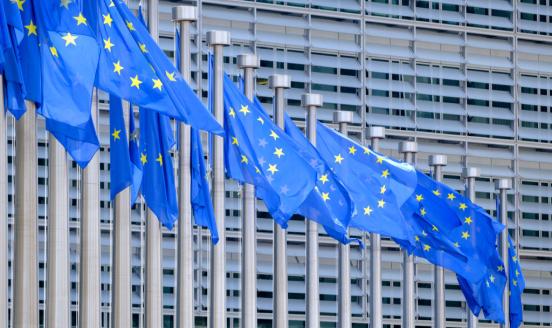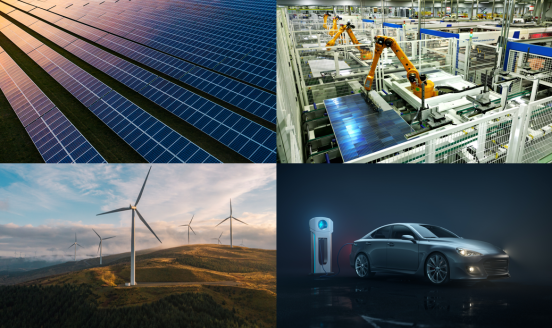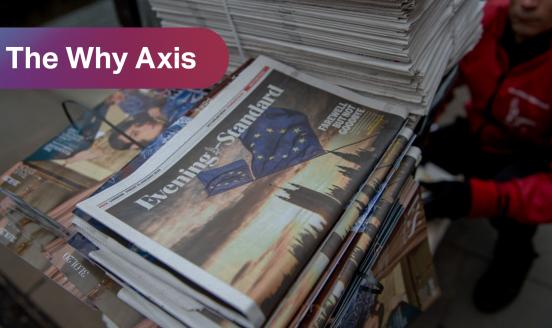A trillion reasons to scrutinise the Green Deal Investment Plan
The European Commission has revealed its €1 trillion investment plan for the European Green Deal. This will not be enough to unleash the expected “gre

One month after unveiling its European Green Deal, the European Commission has revealed its first proposals on the investment pillar of the initiative.
The Commission’s proposals have two main objectives. Firstly, to mobilise the sustainable investments required to reach the EU 2030 climate and energy targets. And secondly, to provide support to territories facing serious socio-economic challenges deriving from the transition towards climate-neutrality.
The Commission claims their proposal would lead to at least €1 trillion of investments over ten years, unleashing a ‘green investment wave’. Could this really be the case? Let’s unpack the European Green Deal Investment Plan to get a sense of its realistic firepower and overall impact in the transition towards a climate-neutral Europe.
What are the investment needs for the European Green Deal?
Let’s start with the investment needed to reach the objectives of the European Green Deal. Most estimates of the yearly average additional investment (public and private) necessary to achieve the EU’s current 2030 climate and energy targets are in the range of €175 billion to €290 billion. The Commission itself assumes in its proposals a ‘green investment gap’ of €260 billion per year by 2030. But these figures refer to the current EU targets, centred on the greenhouse gas (GHG) emissions reduction target of 40% by 2030 relative to 1990 levels. President von der Leyen has made clear that in the context of the European Green Deal these targets will be further deepened, to slash GHG emissions by 50-55% by 2030. This will clearly imply higher investment needs.
All in all, despite the high uncertainty surrounding these estimates, the additional investment requirements to reach the new 2030 targets could thus ultimately be around €300 billion per year over the decade. It must thus be outlined that even if the Commission succeeds in mobilising €1 trillion of investments over ten years, this would just represent a third of the additional investment needs associated with the European Green Deal. This is not a criticism of the Commission, which is trying to make the best out of its very limited budget, but a simple recognition that ultimately only national governments and the private sector will be able to fill the majority of Europe’s ‘green investment gap’, without the help of the EU. The Commission should now focus its efforts on creating the conditions to allow these players to truly unleash ‘a green investment wave’.
How is the magic €1 trillion number reached?
The European Green Deal Investment Plan proposal relies on five main sources of funding:
- EU budget: By raising the share of the EU budget allocated to climate and environmental expenditures from 20% to 25%, the Commission seeks to mobilise €503 billion over the next ten years.
- InvestEU: building on the mechanism behind the Juncker’s Plan, the idea is to provide an EU budget guarantee to the European Investment Bank (EIB) and other promotional banks to allow them to increase their risk-taking and to crowd in private investors in order support investment in Europe. It is supposed to mobilise €650 billion over the next 7-year Multi-annual Financial Framework (MFF), 30% of which devoted to climate projects. As a result, the Commission expects to unleash €279 billion of public and private funds over the next 10 years thanks to an EU budget guarantee for the EIB and other national promotional banks when they invest in European Green Deal associated projects.
- National co-financing: The Commission expects that mobilising €503 billion of the EU budget will trigger additional national co-financing of around €114 billion on climate and environment projects in the next 10 years.
- EU Emissions Trading System funds: Recalling the 2016 reflections of the ‘Monti Report’ on EU own resources, the Commission proposes to devote 20% of the revenues from the auctioning of EU Emissions Trading System (ETS) to the EU budget, for an estimated value of €25 billion over the next 10 years.
- Just Transition Mechanism: With €7.5 billion of ‘fresh’ EU budget resources (in addition to the resources proposed for the whole MFF in May 2018), the Commission intends to leverage at least €100 billion of investments over the period 2021-2027, with financing coming from other sources of the EU budget (European Regional Development Fund and European Social Fund+), co-financing from Member States, as well as contributions from InvestEU and the European Investment Bank (EIB). Extrapolated for the whole decade, the Just Transition Mechanism is thus expected to mobilise around €145 billion over ten years (however, one should be careful of double counting, as some of these funds are already counted in other sources, e.g. in the InvestEU source).
On top of the investment component, the Commission’s proposals also unveiled a commitment to revise relevant State aid rules in light of the policy objectives of the European Green Deal. In practice, the Commission would approve – under certain, flexible, conditions – Member States’ support in a number of areas, spanning from industry decarbonisation to residential energy efficiency, from district heating to circular economy.
What is really new in the European Green Deal Investment Plan?
All in all, the European Green Deal Investment Plan seems to represent a step in the right direction, but some hitches are already worth highlighting.
- As far as the 25% allocation of the EU budget to climate objectives is concerned, it should be outlined that it its overstretched to count the whole €500 billion as filling the investment gap, for three reasons. First, because not all these expenditures can be considered as investments, as they are very diverse (from agriculture subsidies to research and innovation funding). Second, because this actually represents an increase of only 5% compared to the benchmark. This means that the additional expenditures represent only €10 billion and not 50 billion per year (as the Commission seems to imply). And third, because – as highlighted in our own Green Deal paper – it is essential that the Commission reviews the methodology of how expenditures are accounted for as contributing to climate objective, as the current methodology is flawed, and this element is missing in the current proposal.
- With regard to InvestEU, this is indeed the main EU tool to mobilise investments. However, again, the proposal to increase the share of climate-related projects is not new, as it was already proposed by the Commission in May 2018 and agreed in April 2019 by the European Council and Parliament. It should not be counted as additional compared to the baseline scenario. Moreover, the EIB has already committed in November 2019 to increase its climate-related financing from 25% to 50%, so it is important to think critically about the pertinence to provide the EIB with additional guarantees to invest in these projects. There are indeed some opportunity costs in putting money from the EU budget in a guarantee fund, as it could be used better by other EU programmes. This is particularly problematic given the warranted scepticism (based on the experience of the Juncker Plan) on the additionality, and thus on the potential leverage, of the InvestEU initiative.
- Coming to national co-financing, the amounts mentioned are, again, not really additional and the mobilisation is purely mechanical, as there is no incentive for countries to increase their financing in green projects on aggregate. This only represents a reshuffling of money towards projects co-financed with the EU in that field. What is really needed to push EU Member States to increase green investment is a change in the EU fiscal framework, an option which is substantially watered-down in the Commission’s proposal (which just mentions the possibility to discuss this idea in a future “debate on how to improve EU fiscal governance”).
- Finally, it should be outlined that the amounts of ETS funds will depend fully on carbon prices, and for the moment nothing has been announced by the Commission on that front to increase the price significantly. This represents an urgent front in the context of the European Green Deal.
What will the Just Transition Mechanism look like?
The Commission’s proposals also contained more detailed elements on another crucial pillar of the European Green Deal, namely the Just Transition Mechanism. In practice, this initiative will rely on three main pillars to reach the €100 billion threshold promised by President Von der Leyen:
- The creation of a Just Transition Fund endowed with €7.5 billion of ‘fresh money’ (which would be added to the total amount proposed in 2018 for the 2021-2027 MFF). This is supposed to lead to between €30 and 50 billion of additional funds for the regions most affected by the transition.
- Using some part of the InvestEU financing devoted to climate to support a total of €45 billion of investment in ‘Just Transition’ projects between 2021 and 2027.
- The creation of a public sector loan facility at the EIB partly guaranteed by the EU budget to mobilise between €25 to 30 billion of additional public investments in 2021-2027.
There are not many details on the second and third pillar of the Just Transition Mechanism, as the regulation proposal is focused exclusively on the establishment of the Just Transition Fund.
However, on the InvestEU pillar, the Commission’s communication explicitly mentions that the negotiations on InvestEU which have resulted in an agreement between the European Council and Parliament in April 2019 will not be re-opened. This means that the Commission intends to set aside a portion of the financing devoted to InvestEU climate and environment-related investments for ‘just transition’ labelled projects. This represents a share of the provisioning of around €1.8 billion of the EU budget guarantee for the InvestEU programme to reach €45 billion of investment in ‘Just Transition’ projects between 2021 and 2027. And as far as the public sector loan is concerned, the only detail specified for the moment is that the EU budget will contribute with a guarantee of €1.5 billion. However, the proposal does not explain where this money comes from and what EU programme will have to be cut by a similar amount to create this new guarantee. This is problematic. Moreover, we doubt that this last initiative will be very useful at a time when EU countries can finance themselves very easily at very attractive (and in some cases even negative) rates.
Coming back to the Just Transition Fund, the regulation proposal provides more details on the type of projects in which the money will be used. Some of it will be used to invest in private projects and in particular in small and medium sized enterprises, but member states will also be able to use the funds to invest in human capital (e.g. re-skilling and job search assistance). The proposal also explains how the funds will be distributed geographically and what the criteria to access them will be.
As described in details in the allocation method in annex 1 of the proposal, the funds will be pre-allocated by member states depending on multiple criteria: mainly on carbon-intensity and potential job losses in carbon-intensive sectors (coal, peat, oil shale, and manufacturing). However, in order to access to the Just Transition Fund, countries will have to use part of their ERDF and ESF+ funds on these projects, and they will also have to directly co-finance projects. Finally, countries will have to submit ‘territorial just transition plans’ for the most affected regions to justify the funds and to show how they plan to fulfil their climate objectives. Access to the fund will be conditional on the approval of these plans by the Commission.
The pre-allocation might not be the best solution in order to reach the most useful projects in theory, and it might have been preferable to have no ex ante allocation as it is the case for the projects supported by the European Globalisation Adjustment Fund. But, at least, putting some strong conditionality is a good idea given that the fund was created to convince countries to commit to the EU ambitious climate targets. The Commission might thus have found the right balance between pre-allocation and conditionality.
Conclusions
Overall, €1 trillion sounds like a big number, but by itself, the plan will not be sufficient to deliver the investments needed for the European Green Deal: an additional €100 billion per year over ten years would have represented only one-third of the additional investment required in Europe to reach the new 2030 EU climate and energy targets that President von der Leyen has pledged to put forward. The plan will not even deliver these additional €100 billion per year in reality, as it will mainly consist of reshuffled funds from different existing programmes.
To be fair, it would have been difficult for the Commission to do much more, given the limited size of the EU budget. But this clearly outlines that there are other key tools that need to be used to unleash green investments in Europe.
One of these main tools is the EU fiscal framework, which should be reformed to authorise deficit-financed green investment. That is, EU countries should be allowed to seize the opportunity presented by low and even negative interest rates, to invest in green assets. This is the most important tool at the EU’s disposal.
Finally, the Commission should focus on putting in place an enabling framework for private investments to be made. Carbon pricing has an essential role to play in that regard and this is an area where action is required.



